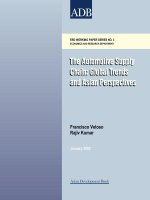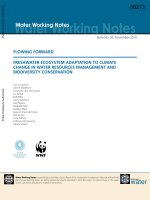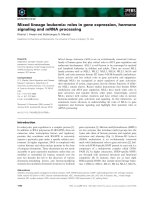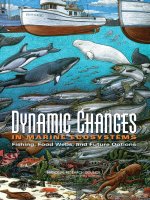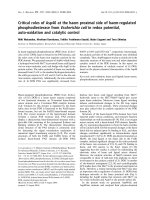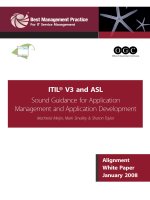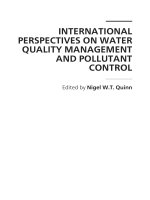Biological Invasions in Marine Ecosystems Ecological, Management, and Geographic Perspectives doc
Bạn đang xem bản rút gọn của tài liệu. Xem và tải ngay bản đầy đủ của tài liệu tại đây (15.65 MB, 635 trang )
Ecological Studies, Vol. 204
Analysis and Synthesis
Edited by
M.M. Caldwell, Washington, USA
G. Heldmaier, Marburg, Germany
R.B. Jackson, Durham, USA
O.L. Lange, Würzburg, Germany
H.A. Mooney, Stanford, USA
E D. Schulze, Jena, Germany
U. Sommer, Kiel, Germany
Volume 189
Ecology of Harmful Algae (2006)
E. Granéli and J.T. Turner (Eds.)
Volume 190
Wetlands and Natural Resource
Management (2006)
J.T.A. Verhoeven, B. Beltman,
R. Bobbink, and D.F. Whigham (Eds.)
Volume 191
Wetlands: Functioning,
Biodiversity Conservation,
and Restoration (2006)
R. Bobbink, B. Beltman, J.T.A. Verhoeven,
and D.F. Whigham (Eds.)
Volume 192
Geological Approaches
to Coral Reef Ecology (2007)
R.B. Aronson (Ed.)
Volume 193
Biological Invasions (2007)
W. Nentwig (Ed.)
Volume 194
Clusia: A Woody Neotropical
Genus of Remarkable Plasticity
and Diversity (2007)
U. Lüttge (Ed.)
Volume 195
The Ecology of Browsing and
Grazing (2008)
I.J. Gordon and H.H.T. Prins (Eds.)
Volume 196
Western North American Juniperus
Communites: A Dynamic Vegetation
Type (2008)
O. Van Auken (Ed.)
Volume 197
Ecology of Baltic Coastal Waters (2008)
U. Schiewer (Ed.)
Volume 198
Gradients in a Tropical Mountain
Ecosystem of Ecuador (2008)
E. Beck, J. Bendix, I. Kottke,
F. Makeschin, R. Mosandl (Eds.)
Volume 199
Hydrological and Biological
Responses to Forest Practices:
The Alsea Watershed Study (2008)
J.D. Stednick (Ed.)
Volume 200
Arid Dune Ecosystems:
The Nizzana Sands in the
Negev Desert (2008)
S W. Breckle, A. Yair,
and M. Veste (Eds.)
Volume 201
The Everglades Experiments: Lessons
for Ecosystem Restoration (2008)
C. Richardson (Ed.)
Volume 202
Ecosystem Organization
of a Complex Landscape:
Long-Term Research
in the Bornhöved
Lake District, Germany (2008)
O. Fränzle, L. Kappen, H P. Blume,
and K. Dierssen (Eds.)
Volume 203
The Continental-Scale Greenhouse Gas
Balance of Europe (2008)
H. Dolman, R. Valentini, and A. Freibauer
(Eds.)
Volume 204
Biological Invasions in Marine
Ecosystems: Ecological, Management,
and Geographic Perspectives (2009)
G. Rilov and J.A. Crooks (Eds.)
Ecological Studies
Further volumes can be found at springer.com
Gil Rilov • Jeffrey A. Crooks
Editors
Biological Invasions
in Marine Ecosystems
Ecological, Management,
and Geographic Perspectives
Editors
Dr. Gil Rilov
Department of Zoology
Cordley 3029
Oregon State University
Corvallis, OR 97331-2914,
USA
Dr. Jeffrey A. Crooks
Tijuana River National Estuarine Research
Reserve and the Southwest Wetlands
Interpretive Association
301 Caspian Way
Imperial Beach
CA 91932,
USA
ISBN: 978-3-540-79235-2 e-ISBN: 978-3-540-79236-9
Ecological Studies ISSN 0070-8356
Library of Congress Control Number: 2008929900
© 2009 Springer-Verlag Berlin Heidelberg
This work is subject to copyright. All rights are reserved, whether the whole or part of the material is
concerned, specifically the rights of translation, reprinting, reuse of illustrations, recitation, broadcasting,
reproduction on microfilm or in any other way, and storage in data banks. Duplication of this publication
or parts thereof is permitted only under the provisions of the German Copyright Law of September 9,
1965, in its current version, and permissions for use must always be obtained from Springer-Verlag.
Violations are liable for prosecution under the German Copyright Law.
The use of general descriptive names, registered names, trademarks, etc. in this publication does not
imply, even in the absence of a specific statement, that such names are exempt from the relevant
protective laws and regulations and therefore free for general use.
Cover illustration: Vectors that have transported marine species around the globe have been operating
for millennia, but the diversity and intensity of vector activity has increased dramatically in recent years.
The drawing on the book cover depicts the change in the types of one particularly important vector,
oceangoing vessels, over this time frame. In the first millennium, large canoes were used by the
Polynesian people to travel around the Pacific and occupy new lands, and the Vikings crossed the
Atlantic in longships. These were replaced by large sailing ships that traversed the oceans during most
of the second millennium, only to be replaced by huge freighters and tankers that dominate the seas
today. With this change, the vectors changed in size and mode of transfer of marine invaders from fouling
only, to fouling and dry ballast, to fouling and ballast waters. With the change in the size of vessels and
the number of routes and voyages as well as the proliferation of other invasion vectors such as canals,
fisheries and trade in pets, bait and seafood, the number of invasive species has dramatically increased.
The graph represents this increase, from just a few species such as woodborrowing shipworms (Teredo spp)
to a multitude of species that take advantage of the many ways in which marine species now move
around the world (Design Gil Rilov).
Cover design: WMXDesign GmbH, Heidelberg, Germany
Printed on acid-free paper
9 8 7 6 5 4 3 2 1
springer.com
Preface
The timing of the publication of this book couldn’t be better as we celebrate the
50th anniversary of Charles Elton’s seminal book, The Ecology of Invasions by
Animals and Plants. Since this influential book was published in 1958, the study of
bioinvasions has developed exponentially, alongside the exponential growth in the
magnitude of the invasion problem itself. Today, bioinvasion, a highly complex
ecological process and environmental concern, has become a specific branch in
ecology and environmental studies, with many disciplines developing within it.
In early 2004 one of us (G.R.) received a letter from Springer Publishers asking
to consider writing or editing a book on marine bioinvasions for their Ecological
Studies Series. Springer’s editors have been thinking of such a book for quite a
while — and rightfully so. Over the past several decades, many books have been
written on management, evolutionary or ecological perspectives of bioinvasions,
but those books have focused mostly on terrestrial invasions with only a few marine
examples. Research on marine bioinvasions has been mounting in the last two dec-
ades; a special biannual international symposium on the topic was established in
1999, signifying the fact that it has become a discipline in its own right, but no
comprehensive marine bioinvasions book existed at that time. Today, four years
later, this is still the first of its kind.
The challenge was exciting and, because the book’s purpose was to reflect the
full breadth of this fascinating topic, it warranted the inclusion of knowledge of
many expert contributors. Dr. Jeff Crooks joined in as a co-editor, and we launched
on this long journey together. It was a perfect match: both of us have worked on
invasive mussels and their interactions with the native communities, one (G.R.) in
one of the hottest hotspots of marine bioinvasions on earth, the eastern Mediterranean,
and the other (J.C.) in one of the hotspots on the West Coast of North America,
Southern California.
Together, we envisioned a book that will focus mainly on the ecological aspects
of the invasion process in the marine environment, which in many ways is quite
different to the terrestrial one. With the help of Prof. Jim Carlton, we crafted an
outline for a book that would depict the different stages of the invasion process,
discuss management issues, and present illustrative case studies from different
regions of the world. Identifying prospective contributors was the easy part of the
task: many excellent experts could address these different processes. The big
v
question was would these very prolific, busy, and active researchers be willing and
able to contribute to this effort? The response was heartening: when we presented
the idea to our prospective contributors, the excitement and willingness to commit
were overwhelming. Within ten days, we had a list of chapter authors that would
cover most of the topics we envisioned. This rapid and positive response reempha-
sized the great thirst for such a book.
One of the challenges in producing this book is that the topic is so “hot” and
rapidly evolving that it is hard to keep up with the new science. This is for two main
reasons. The first is that new invasions are being discovered weekly in many
regions, and the second is that new basic research is continuously being produced
on new, as well as older, invasions. With every iteration of the book’s production,
new material seemed appropriate for inclusion and we were bound to draw the line
somewhere. Yet this is what made this project so exciting. It became clear that it is
impossible to include everything we might have wanted in this one book. Luckily,
there are other excellent books on the general theory of bioinvasions that cover
many of the topics of which we could only scratch the surface. Many are mentioned
in the introductory chapter.
The dedicated contributing authors of this book made great efforts to keep the
content as updated and relevant as possible. This enables our book, we believe, to
serve as an up-to-date learning tool for students and a valuable asset for profession-
als in the field. Editing such an encompassing book wasn’t always an easy assign-
ment, and quite challenging at times; still, we have thoroughly enjoyed this creative
work. We are grateful to Springer Publishers for their support during this process,
and mostly we thank our devoted chapter authors without which this book would
not exist. We also thank our patient families, Iris, Shai and Shir Rilov, and Emma,
Kai, and Aiden Crooks, for allowing us many hours of seclusion working on the
book. We hope that Biological Invasions in Marine Ecosystems: Ecological,
Management, and Geographic Perspectives will serve its purpose and broaden the
knowledge and understanding of this important topic.
June 2008 Gil Rilov, USA
Jeff Crooks, USA
vi Preface
Contents
Section I Perspectives on Marine Invasions
1 Marine Bioinvasions: Conservation Hazards and Vehicles
for Ecological Understanding 3
Gil Rilov and Jeffrey A. Crooks
1.1 Introduction – The Problem of Biological Invasions 3
1.2 Invasions as a Tool to Study Nature 5
1.3 Invasion Biology – The Discipline and its Application
in the Marine Environment 6
1.4 Structure of the Book 7
1.5 Note on Terminology 8
1.6 Concluding Thoughts 9
References 9
2 Deep Invasion Ecology and the Assembly of Communities
in Historical Time 13
James T. Carlton
2.1 Introduction 13
2.2 Invader Underestimation – Systematics 14
2.2.1 Cryptogenic Species 14
2.2.2 Pseudoindigenous Species 16
2.3 Invader Underestimation – Biogeographic
and Community History 39
2.3.1 Widespread Intraoceanic and Interoceanic
Corridor Species 39
2.3.2 Neritic Species with Presumptive Oceanic Dispersal 40
2.3.3 Resident Species 41
2.4 Invader Underestimation – Sampling 42
2.4.1 Species in Underexplored Habitats and Associations 42
2.4.2 Incipient Invasions: Species with Small
Population Sizes 42
2.5 The Overestimation of Invader Diversity 43
vii
viii Contents
2.6 Discussion 44
2.7 The Way Forward: Solutions 47
References 48
3 Natural and Climate Change Mediated Invasions 57
Steve I. Lonhart
3.1 Introduction 57
3.2 The Geographic Range of a Species 57
3.3 Range Shifts 58
3.3.1 Factors that Influence our Understanding
of the Geographic Range and Range Limits 58
3.3.2 Natural Range Shifts 60
3.3.3 Human-mediated Range Shifts 62
3.4 Climate Change and Range Shifts 63
3.4.1 Observed Biological Responses to Climate Change 63
3.5 Contrasting Natural Range Expansions
and Biological Invasions 66
3.6 Conclusions 67
References 67
4 Modeling Marine Invasions: Current and Future Approaches 71
Marjorie J. Wonham and Mark A. Lewis
4.1 Introduction 71
4.1.1 Why Marine Invasion Modeling? 71
4.1.2 Scope of this Review 72
4.2 Invasion Pathway Models 73
4.3 Population Models: Invasion Dynamics 74
4.3.1 Single-species Models 79
4.3.2 Multi-species Models 80
4.4 Population Models: Invasion Spread 84
4.4.1 Single-species Models 85
4.4.2 Allee Effects 87
4.4.3 Multi-species Models 90
4.5 Community Invasibility Models 93
4.6 Summary and Future Directions 94
4.6.1 Formalizing Conceptual Models Mathematically 94
4.6.2 Coupling Dynamical and Statistical Models 96
4.6.3 Integrating Modeling and Empirical Work 97
References 98
Appendix 105
Contents ix
Section II Invader Arrival
5 Characterizing Vectors of Marine Invasion 109
Dan Minchin, Stephan Gollasch, Andrew N. Cohen,
Chad L. Hewitt, and Sergej Olenin
5.1 Introduction 109
5.2 Primary vs Secondary Introductions 109
5.3 Principal Vectors of Marine Invasion 110
5.3.1 Shipping 110
5.3.2 Canals 110
5.3.3 Aquaculture 111
5.3.4 Fisheries 111
5.3.5 Ornamental Species and Live Seafood 112
5.3.6 Marine Leisure and Tourism 112
5.3.7 Research and Education 112
5.3.8 Habitat Restoration and Management 113
5.4 Vector Management 113
References 115
6 The Vessel as a Vector – Biofouling, Ballast Water
and Sediments 117
Chad L. Hewitt, Stephan Gollasch, and Dan Minchin
6.1 Introduction 117
6.2 Biofouling 120
6.3 Ballast Water and Sediments 124
6.4 Discussion 126
References 129
7 The Role of Propagule Pressure in Invasion Success 133
Emma L. Johnston, Richard F. Piola, and Graeme F. Clark
7.1 Introduction 133
7.2 Propagule Pressure 133
7.3 The Resilience of Propagules 135
7.4 Producing Propagules 138
7.5 Inferring Propagule Supply from Current Distributions 139
7.6 Vectors and Propagule Supply 141
7.7 Manipulating Propagule Supply 142
7.7.1 Manipulating Propagule at the Larval Stage 143
7.7.2 Manipulating Adult Invaders 145
7.8 Conclusions 146
References 147
x Contents
8 Differentiating Successful and Failed Invaders:
Species Pools and the Importance of Defi ning Vector,
Source and Recipient Regions 153
A. Whitman Miller and Gregory M. Ruiz
8.1 Introduction 153
8.2 Identifying the Roles of Source Region, Recipient
Region and Vector 154
8.3 Modeling Invasion State Space – Defi ning
and Comparing Species Pools 156
8.3.1 Species Pool Designations 157
8.3.2 Species Pool Designations and Comparisons
(Fixed Recipient, Source, and Vector) 159
8.3.3 Fixed Recipient and Source Regions,
Multiple Vectors 160
8.3.4 Fixed Recipient Region, Multiple Source
Regions, Multiple Vectors 162
8.3.5 Multiple Recipient Regions, Fixed Source
Region, Multiple Vectors 163
8.4 Some Recent Analyses of Invader Attributes Using Species
Pool Comparisons 163
8.5 Discussion 167
References 169
Section III Invader Establishment
9 The Establishment of Invasive Species 173
Jeffrey A. Crooks and Gil Rilov
9.1 Introduction 173
9.2 Factors Infl uencing Numeric and Geographic Growth
of Invasive Populations 173
References 174
10 The Role of Phenotypic Plasticity in Marine Biological
Invasions 177
L. David Smith
10.1 Introduction 177
10.2 Phenotypic Plasticity 178
10.2.1 A Brief Overview 178
10.2.2 General Importance to Invasions 180
10.2.3 Empirical Work in Non-marine Systems 182
10.3 Phenotypic Plasticity in Marine Systems 183
10.4 Where Phenotypic Plasticity Might Play a Role in
Marine Invasions 187
Contents xi
10.4.1 Habitats 187
10.4.2 Taxonomic Groups 188
10.4.3 Steps in the Invasion Sequence 188
10.4.4 Vectors 189
10.5 Examples of Phenotypic Plasticity’s Effect
in Marine Invasions 191
10.5.1 Post-invasion Effects 191
10.5.2 The Invasion of Carcinus maenas in the
Gulf of Maine 192
10.6 Future Research Directions 194
References 196
11 Escape from Parasites 203
Mark E. Torchin and Kevin D. Lafferty
11.1 Introduction 203
11.2 Reasons for Parasite Escape 205
11.3 Consequences of Parasite Release 207
11.4 Fishes 207
11.5 Molluscs 208
11.6 Crabs 210
11.7 Conclusion 210
References 211
12 Ecological Factors Affecting Community Invasibility 215
Suzanne V. Olyarnik, Matthew E.S. Bracken, Jarrett E. Byrnes,
A. Randall Hughes, Kristin M. Hultgren, and John J. Stachowicz
12.1 Introduction 215
12.2 The Abiotic Filter 216
12.3 Resource Levels 218
12.4 Biotic Resistance and Species Diversity 219
12.4.1 Experimental vs Observational Approaches 221
12.4.2 Large- vs Small-scale Studies 224
12.5 Facilitation 225
12.5.1 Increasing Resource Availability 225
12.5.2 Ameliorating Physical Stress 227
12.5.3 Facilitation Cascades and “Invasional Meltdown” 227
12.6 Disturbance 228
12.7 Historical Context 231
12.8 Conclusion 232
References 233
xii Contents
Section IV Invader Integration into Ecosystems
13 The Integration of Invasive Species into Marine Ecosystems 241
Gil Rilov
13.1 Introduction 241
13.2 Are Most Marine Invasions Ecologically Harmless? 241
13.3 Ecological Interactions of Marine Invaders 243
13.4 Conclusion 244
Reference 244
14 Competition in Marine Invasions 245
James E. Byers
14.1 Introduction 245
14.2 A Review of the Competition Literature on Marine
Invasive Species 246
14.2.1 What Exotic Taxa are Studied for Competitive
Interactions? 247
14.2.2 What Regions and Habitats are Studied? 249
14.2.3 How Often Does Competition Occur
and How Are Its Effects Measured/Indexed? 249
14.3 Should Competition be Stronger in Human
Mediated Invasions? 252
14.4 Caveats to the Conclusion of Strong and Frequent
Competition in the Marine Invasion Literature 254
14.5 Future Directions 256
14.6 Conclusion 257
References 258
15 Predator-Prey Interactions of Marine Invaders 261
Gil Rilov
15.1 Introduction 261
15.2 The Role of Predation in Marine Communities 261
15.3 Predator-prey Interactions in Invaded Systems:
A Literature Review 264
15.3.1 Descriptive Statistics of Predator-prey
Interactions in Invaded Systems 265
15.3.2 Invasions of Predatory Zooplankton 274
15.3.3 Predation as an Invasion-control Mechanism 276
15.3.4 Predation by Invaders as a Facilitative Force
for Further Invasions 278
15.4 Conclusion 279
References 281
Contents xiii
16 The Role of Exotic Marine Ecosystem Engineers 287
Jeffrey A. Crooks
16.1 Ecosystem-Level Impacts 287
16.2 Engineering 289
16.2.1 Autogenic vs Allogenic Engineering 289
16.2.2 Indirect Effects of Engineering on Food Webs
and Nutrient Cycling 291
16.3 Detecting Engineering Effects 292
16.3.1 Effects on Abiotic Environment Alone 292
16.3.2 Comparisons of Invaded and Uninvaded Areas 293
16.3.3 Experimental Approaches 293
16.4 Effects of Exotic Engineers on Abiotic Factors
and Processes 294
16.4.1 Water Column and Hydrodynamic Conditions 295
16.4.2 Sedimentation and Benthic Conditions 295
16.4.3 Plants and Animals as Agents
of Structural Change 296
16.4.4 Net Effects of Exotic-induced Changes
to Habitat Complexity 297
16.4.5 Scale 298
16.5 Implications 299
References 300
17 Multitrophic Effects of Invasions in Marine
and Estuarine Systems 305
Edwin D. Grosholz and Gregory M. Ruiz
17.1 Introduction 305
17.2 Multitrophic Impacts 306
17.3 Case History #1:
The Ecosystem Engineer Spartina in West Coast
Estuaries 310
17.4 Case History #2: Contrasting Trophic Effects
of a Non-Native and Native Predator in a Central
California Estuary 313
17.5 Invasions as Disturbance: A Framework for Understanding
Multitrophic-level Impacts 315
17.6 Conclusions 319
References 320
xiv Contents
Section V Management Perspectives
18 Marine Bioinvasion Management: Structural Framework 327
Chad L. Hewitt, Richard A. Everett, Naomi Parker,
and Marnie L. Campbell
18.1 Introduction 327
18.2 Inaction vs Action 327
18.3 Marine Biosecurity – Prevention, Regulation,
and Management of Invasions 328
18.4 Other Management Options 330
References 331
Additional Literature 332
Ballast Water 332
Biofouling 333
Biological Control 333
19 Examples of Current International, Regional and National
Regulatory Frameworks for Preventing and Managing
Marine Bioinvasions 335
Chad L. Hewitt, Richard A. Everett, and Naomi Parker
19.1 Introduction 335
19.2 International Frameworks 336
19.2.1 General Obligations 336
19.2.2 International Quarantine Agreements 337
19.2.3 Convention on Biological Diversity 338
19.2.4 Vector-based International Instruments 339
19.3 Regional Multi-lateral Frameworks 341
19.3.1 Helsinki Commission 342
19.3.2 Asia-Pacific Economic Cooperation 342
19.4 National Examples 343
19.4.1 Australia 343
19.4.2 New Zealand 344
19.4.3 USA 346
19.5 Conclusions 348
References 349
20 An Overview of Risk Assessment in a Marine
Biosecurity Context 353
Marnie L. Campbell
20.1 Introduction 353
20.1.1 Defi ning Endpoints 354
20.1.2 Core Values 354
Contents xv
20.1.3 Uncertainty and the Precautionary
Principle/Approach 355
20.1.4 Quantitative vs Qualitative 356
20.2 Types of Risk Assessment 357
20.3 Species Level Risk Assessment 358
20.3.1 Species Level Risk Assessment Examples 358
20.4 Vector Based Risk Assessment 361
20.4.1 Vector Based Risk Assessment Examples 362
20.5 Pathway Risk Assessment 367
20.5.1 Pathway Risk Assessment Examples 367
20.6 Conclusions 369
References 370
21 Differing Consequences of Removing Ecosystem-Modifying
Invaders: Signifi cance of Impact and Community Context
to Restoration Potential 375
Sally D. Hacker and Megan N. Dethier
21.1 Introduction 375
21.2 A Predictive Conceptual Model for Post-removal
Restoration 377
21.3 Context Dependent Restoration: Invasive English
Cordgrass as an Example 380
21.4 Conclusions 383
References 383
Section VI Geographic Perspectives
22 Geographic Perspectives of Invasions in the Sea 389
Jeffrey A. Crooks and Gil Rilov
22.1 Introduction 389
22.2 The Emerging Global Picture of Marine
Invasion – Possibilities and Precautions 389
References 390
23 The Status and Distribution of Marine Alien Species
in South Africa 393
Charles L. Griffiths, Tamara B. Robinson, and Angela Mead
23.1 Introduction 393
23.2 Cnidaria 393
23.3 Polychaeta 396
23.4 Cirripedia 396
23.5 Isopoda 396
23.6 Amphipoda 396
xvi Contents
23.7 Decapoda 397
23.8 Bryozoa 397
23.9 Bivalvia 398
23.10 Gastropoda 400
23.11 Echinoidea 401
23.12 Ascidiacea 401
23.13 Pisces 402
23.14 Rhodophyta 402
23.15 Patterns and Adequacy of Data 402
23.16 Additional Cryptogenic Species 405
References 406
24 Marine Invasions in New Zealand: A History of Complex
Supply-Side Dynamics 409
Barbara J. Hayden, Graeme J. Inglis, and David R. Schiel
24.1 Introduction 409
24.2 Status of Marine Invasions in NZ 410
24.3 What is Non-native? 411
24.4 Evidence of the Leaky Border 413
24.5 Reasons Why Introductions Continue 413
24.6 Most Common Marine Pathways 414
24.6.1 Ballast Water 414
24.6.2 Hull Fouling and Sea Chests 415
24.7 The Dynamic Nature of Incursion Risk 415
24.8 Changes in the Source of Invaders 416
24.9 The Complexity of Making Forecasts 418
24.10 Conclusion 421
References 421
25 Marine Bioinvasions in Australia 425
Cathryn Sliwa, Sasha Migus, Felicity McEnnulty,
and Keith R. Hayes
25.1 Introduction 425
25.2 Non-native and Cryptogenic Marine Species in Australia 428
25.3 Problems with Lists of Non-Native and Cryptogenic Species 433
References 435
26 Marine Bioinvasions in the Southeastern Pacifi c: Status,
Ecology, Economic Impacts, Conservation and Management 439
Juan C. Castilla and Paula E. Neill
26.1 Introduction 439
26.2 Background Information on the Chilean Marine System 440
Contents xvii
26.3 Marine NIS Introductions in Chile 441
26.3.1 Likely Pathways of Marine NIS Introductions 445
26.3.2 Likely Donor Areas of Marine NIS 446
26.4 Socio-economic Impacts of NIS 447
26.4.1 Positive Impacts 447
26.4.2 Negative Impacts 448
26.5 Ecology and Conservation of Marine NIS in Chile 448
26.6 Marine NIS in Peruvian Waters 450
26.7 Comparative Analysis of NIS in Chile 450
26.8 Marine NIS Regulations in Chile 452
26.9 Conclusions and Recommendations 453
References 454
27 Marine Bioinvasions in the Brazilian Coast: Brief Report
on History of Events, Vectors, Ecology, Impacts and Management
of Non-indigenous Species 459
Carlos Eduardo Leite Ferreira, Andrea de Oliveira Ribeiro Junqueira,
Maria Célia Villac, and Rubens Mendes Lopes
27.1 Introduction 459
27.2 The Plankton Realm 461
27.2.1 Phytoplankton Species 461
27.2.2 Zooplankton Species 462
27.3 The Benthic Realm 463
27.3.1 Phytobenthos 463
27.3.2 Zoobenthos 464
27.4 Fishes 470
27.5 Intentional Introductions Related to Marine Farming 471
27.6 Final Remarks 472
References 473
28 Four Centuries of Biological Invasions in Tidal Waters
of the Chesapeake Bay Region 479
Paul W. Fofonoff, Gregory M. Ruiz, Anson H. Hines,
Brian D. Steves, and James T. Carlton
28.1 Introduction 479
28.2 Description of the Chesapeake Bay Region 481
28.2.1 Physical Features 481
28.2.2 History of Biological Studies 482
28.3 Patterns of Invasion in the Chesapeake Bay Region 483
28.3.1 Taxonomic Composition and Residency 483
28.3.2 Changing Patterns of Invasion Over Time 486
28.4 Conclusions 497
References 502
xviii Contents
29 Introduced Aquatic Species of the North Sea Coasts
and Adjacent Brackish Waters 507
Stephan Gollasch, Deniz Haydar, Dan Minchin, Wim J. Wolff,
and Karsten Reise
29.1 Introduction 507
29.2 Non-indigenous Aquatic Species in the North Sea Region 508
29.3 Cryptogenic Species 516
29.4 Nonindigenous Species Recorded in the North Sea
as a Result of Natural Dispersal 518
29.5 Case Histories 518
29.5.1 Crepidula fornicata – the Slipper Limpet 519
29.5.2 Eriocheir sinensis – the Chinese Mitten Crab 521
29.5.3 Teredo navalis – the Shipworm 522
29.6 Conclusions 524
References 525
30 European Enclosed and Semi-enclosed Seas 529
Erkki Leppäkoski, Tamara Shiganova, and Boris Alexandrov
30.1 Introduction 529
30.2 The Black Sea 532
30.2.1 Origin of Native Biota 533
30.2.2 Nonindigenous Flora and Fauna 533
30.2.3 Case Histories 534
30.2.4 Vectors, Modes of Transmission 536
30.3 The Caspian Sea 536
30.3.1 Origin of Native Biota 537
30.3.2 Nonindigenous Flora and Fauna 537
30.3.3 Origin of Nonindigenous Species 539
30.3.4 Vectors, Modes of Transmission 540
30.4 The Baltic Sea 540
30.4.1 Origin of Native Biota 541
30.4.2 Nonindigenous Flora and Fauna 541
30.4.3 Origin of the NIS 542
30.4.4 Vectors, Modes of Transmission 543
30.5 Conclusions 544
References 544
31 Marine Bioinvasions in the Mediterranean Sea – History,
Distribution and Ecology 549
Gil Rilov and Bella Galil
31.1 Introduction 549
31.2 The Mediterranean Sea: A “Hotspot” of Marine
Bioinvasions 551
31.2.1 Spatial Patterns 552
Contents xix
31.2.2 Temporal Patterns 554
31.2.3 Ecological Characteristics of Mediterranean
Invaders (Fish) 554
31.3 Erythrean Invasion Through the Suez Canal 555
31.3.1 A History of Dramatic Changes 557
31.3.2 The Warm Winter of 1954–55 558
31.3.3 The Eastern Mediterranean Climatic Transient 559
31.3.4 Ecological Interactions of Erythrean Invaders
in the Receiving Environment 560
31.3.5 Impacts of the Erythrean Invasion
on Human Activity 563
31.4 Lagoons as Invasion Hotspots 564
31.5 Infamous Invaders 566
31.5.1 Macrophytes 566
31.5.2 Animals 568
31.6 Conclusions 569
References 570
32 A First Assessment of Invasive Marine Species on Chinese
and Korean Coasts 577
Kyung S. Seo and Yoon Lee
32.1 Introduction 577
32.2 Marine Invaders in Korea and China 577
32.2.1 Pathogens in the Mariculture Industry 580
32.2.2 Mussels 581
32.2.3 Sea Stars 581
32.2.4 Tunicates 582
32.2.5 Bryozoans 582
32.2.6 Phytoplankton 582
32.3 Vectors of Invasions into Korean and Chinese Waters 582
32.4 Conclusion 583
References 583
33 Invasions of Estuaries vs the Adjacent Open Coast:
A Global Perspective 587
Rikke K. Preisler, Kerstin Wasson, Wim J. Wolff,
and Megan C. Tyrrell
33.1 Habitat Differences in Marine Invasion Rates 587
33.2 An Estuarine Emphasis to Marine Invasion Research 588
33.3 A Synthesis of Global Temperate Invertebrate
Data on Invasions 589
33.3.1 Estuarine vs Open Coast Invasions 589
33.3.2 Regional Differences in Estuarine
vs Coastal Invasions 594
xx Contents
33.4 Hypotheses for Higher Invasion Rates of Estuaries
vs Coasts 605
33.4.1 Greater Alien Propagule Pressure in Estuaries 605
33.4.2 Estuarine Species are Better Suited to Estuarine
Conditions 607
33.4.3 Establishment is Facilitated by the Limited
Circulation in Estuaries 609
33.4.4 Estuaries Have Undergone More Human
Alterations 610
33.4.5 Estuaries Have More “Empty Niches” 612
33.5 Directions for Future Research 614
33.6 Conclusions 615
References 615
Section VII Concluding Thoughts
34 Future Directions For Marine Invasions Research 621
Jeffrey A. Crooks and Gil Rilov
34.1 Introduction 621
34.2 Scientifi c Considerations 621
34.3 Management Considerations 622
34.4 Social Considerations 623
34.5 Conclusions 624
References 624
Subject Index 627
Taxonomic Index 631
Contributors
xxi
Boris Alexandrov
Institute of Biology of the Southern Seas, National Academy of Sciences
of Ukraine, Odessa Branch, Odessa, Ukraine
Matthew E. S. Bracken
Northeastern University, Marine Science Center, 430 Nahant Road, Nahant,
MA 01908, USA
James E. Byers
Department of Zoology, University of New Hampshire, 46 College Rd.,
Durham, NH 03824, USA
Jarrett Byrnes
UC Davis Bodega Marine Laboratory, PO Box 247, Bodega Bay, CA 94923, USA
Marnie Campbell
Department of Conservation and Ecology, National Centre for Marine
Conservation & Resource Sustainability, Australian Maritime College,
Locked Bag 1370, Newnham Tasmania 7250, Australia
James T. Carlton
Maritime Studies Program, Williams College-Mystic Seaport, PO Box 6000,
Mystic, CT 06355, USA
Juan Carlos Castilla
Departamento de Ecología y Centro de Estudios Avanzados en Ecología
y Biodiversidad. Faltad de Ciencias Biológicas. Pontificia Universidad
Católica de Chile. Santiago, Chile
Graeme F Clark
Centre for Evolution and Ecology, School of Biological, Earth and Environmental
Sciences, University of New South Wales, Sydney 2052, NSW, Australia
Andrew N. Cohen
San Francisco Estuary Institute, 7770 Pardee Lane, Oakland, CA 94621, USA
Jeffrey A. Crooks
Tijuana River National Estuarine Research Reserve and the Southwest Wetlands
Interpretive Association, 301 Caspian Way, Imperial Beach, CA 91932, USA
Megan N. Dethier
Friday Harbor Laboratories, 620 University Road, University of Washington,
Friday Harbor, WA 98250, USA
Carlos Eduardo Leite Ferreira
Departamento de Biologia Marinha, Universidade Federal Fluminense,
Niterói-RJ, 24001-970, Brazil
Paul W. Fofonoff
Smithsonian Environmental Research Center, PO Box 28, Edgewater,
MD 21037, USA
Bella Galil
National Institute of Oceanography, Israel Oceanographic and Limnological
Research, P.O.B. 8030, Haifa 31081Israel
Stephan Gollasch
GoConsult, Grosse Brunnenstr. 61, 22763 Hamburg, Germany
Charles Griffiths
Zoology Department, University of Cape Town, Private Bag X3, Rondebosch
7701, South Africa
Edwin D. Grosholz
Department of Environmental Science and Policy, One Shields Avenue,
University of California Davis, Davis, CA 95616, USA
Sally D. Hacker
Department of Zoology, 3029 Cordley Hall, Oregon State University, Corvallis,
OR 97331, USA
xxii Contributors
Deniz Haydar
University of Groningen, Department of Marine Benthic Ecology and Evolution,
PO Box 14, 9750 AA Haren, The Netherlands
Barbara Hayden
National Institute of Water & Atmospheric Research Ltd (NIWA), PO Box 8602,
Christchurch 8440, New Zealand
Keith R. Hayes
CSIRO Division of Mathematical and Information Sciences, GPO Box 1538,
Hobart Tasmania, 7001, Australia
Chad L. Hewitt
Australian Maritime College, Locked Bag 1399, Launceston,
Tasmania 7250, Australia
Anson H. Hines
Smithsonian Environmental Research Center, PO Box 28, Edgewater,
MD 21037, USA
Randall Hughes
UC Davis Bodega Marine Laboratory, PO Box 247, Bodega Bay, CA 94923, USA
Kristin Hultgren
Smithsonian Tropical Research Institute, Unit 0948, APO AA 34002-0948, USA
Graeme Inglis
National Institute of Water & Atmospheric Research Ltd (NIWA), PO Box 8602,
Christchurch 8440, New Zealand
Emma L Johnston
Centre for Evolution and Ecology, School of Biological, Earth and Environmental
Sciences, University of New South Wales, Sydney 2052, NSW Australia,
Andrea de Oliveira Ribeiro Junqueira
Instituto de Biologia, Universidade Federal do Rio de Janeiro, Rio de Janeiro-RJ,
21949-900, Brazil
Contributors xxiii
Kevin D. Lafferty
U.S. Geological Survey, Western Ecological Research Center, c/o Marine
Science Institute, University of California, Santa Barbara, CA 93106, USA
Yoon Lee
Environment Research Department, National Fisheries Research and
Development Institute, Ministry for Food, Agriculture, Forestry and Fisheries,
152-1, Haean-ro, Gijanag-eup, Gujang-gun
Erkki Leppäkoski
Åbo Akdademi University, Environmental and Marine Biology, 20500 Turku,
Finland
Mark A. Lewis
Centre for Mathematical Biology, Department of Biological Sciences and
Department of Mathematical & Statistical Sciences, University of Alberta,
Edmonton, Alberta, Canada T6G 2G1
Steve I. Lonhart
Monterey Bay National Marine Sanctuary, NOAA and Institute of Marine
Sciences, University of California 110 Shaffer Road, Santz Cruz, CA 95060, USA
Rubens Mendes Lopes
Instituto Oceanográfico, Universidade de São Paulo, São Paulo-SP, 05508-900,
Brazil
A. Whitman Miller
Smithsonian Environmental Research Center, PO Box 28, Edgewater, MD 21037, USA
Dan Minchin
Marine Organism Investigations, 3 Marina Village, Ballina, Killaloe,
Co Clare, Ireland
Paula Emily Neill
Universidad Católica de la Santísima Concepción, Facultad de Ciencias,
Departamento de Ecología Costera, Casilla 297, Concepción, Chile
Sergej Olenin
Coastal Research and Planning Institute, Klaipeda University, H. Manto 84,
92294 Klaipeda, Lithuania
xxiv Contributors

